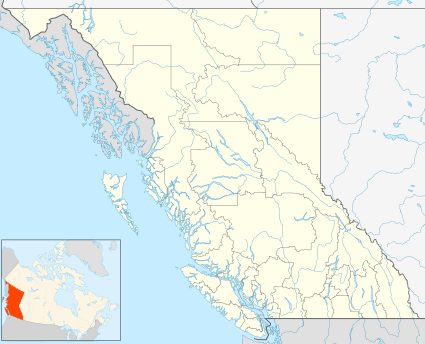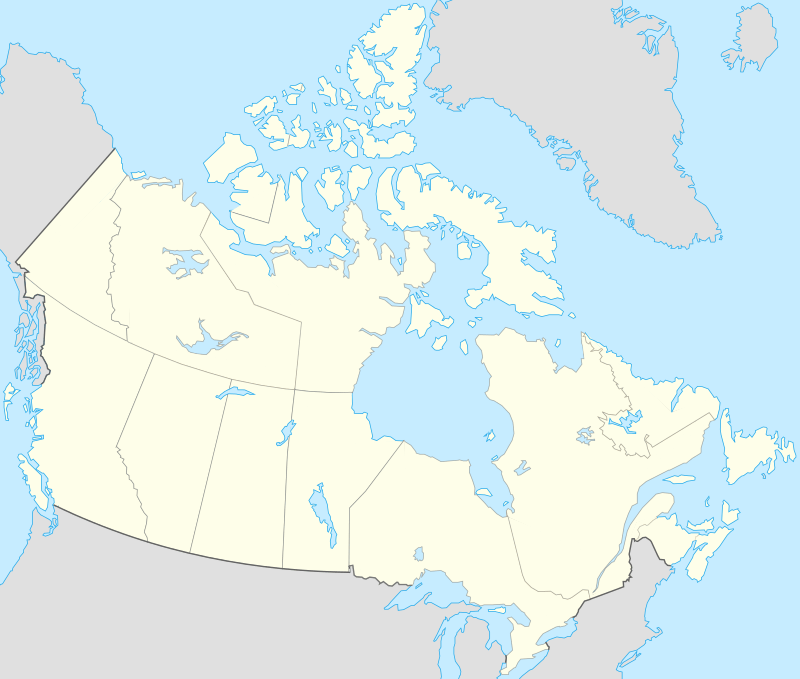Houston, British Columbia
Houston (/ˈhjuːstən/) is a forestry, mining and tourism town in the Bulkley Valley of the Northern Interior of British Columbia, Canada. Its urban population is approximately 3600 people, with approximately 2000 in the surrounding rural area. It is known as the "steelhead capital" and it has the world's largest fly fishing rod. Houston's tourism industry is largely based on ecotourism and Steelhead Park, situated along Highway 16. Houston is named in honour of the pioneer newspaperman John Houston.[2]
Houston | |
|---|---|
| District of Houston[1] | |
 Houston Location of Houston in British Columbia  Houston Houston (Canada) | |
| Coordinates: 54°23′51″N 126°38′31″W | |
| Country | Canada |
| Province | British Columbia |
| Region | Bulkley Valley |
| Regional district | Regional District of Bulkley-Nechako |
| Incorporated | 1957 |
| Government | |
| • Mayor | Shane Brienen |
| Area | |
| • Total | 72.94 km2 (28.16 sq mi) |
| Elevation | 610 m (2,000 ft) |
| Population (2016) | |
| • Total | 2,993 |
| • Density | 41.0/km2 (106/sq mi) |
| Time zone | UTC−08:00 (PST) |
| • Summer (DST) | UTC−07:00 (PDT) |
| Area code(s) | 250 / 778 / 236 |
| Highways | |
| Website | District of Houston |
History
| Year | Pop. | ±% |
|---|---|---|
| 1961 | 699 | — |
| 1966 | 699 | +0.0% |
| 1971 | 2,232 | +219.3% |
| 1976 | 2,673 | +19.8% |
| 1981 | 3,921 | +46.7% |
| 1986 | 3,905 | −0.4% |
| 1991 | 3,628 | −7.1% |
| 1996 | 3,934 | +8.4% |
| 2001 | 3,577 | −9.1% |
| 2006 | 3,163 | −11.6% |
| 2011 | 3,147 | −0.5% |
| 2016 | 2,993 | −4.9% |
| Source: Statistics Canada [3][4][5][6][7][8][9] | ||
The Morice area was first charted by amateur historian, cartographer and geologist, Reverend Adrien-Gabriel Morice (1859-1938) known to northern British Columbian locals as "Father Morice." In 1880, Morice came to British Columbia as a Catholic missionary to the native people and was one of the first 'white men' to see most of the area. Morice wrote, The History of the Northern Interior of British Columbia (formerly New Caledonia) [1660 to 1880]. The Indigenous people were initially known as Carrier Indians, but today are more commonly referred to as the Wet'suwet'en (sometimes spelled Wit'suwit'en) and speak a language commonly referred to as Dakeł (Northern Athabaskan or Na-Dene language). The Morice River is called "Wet-zuhn-kwa" by the Wet'suwet'en people because of the bluish-green colour of the water.
Wet-zuhn-kwa produces fresh water species like rainbow trout, cutthroat trout, and Dolly Varden trout (bull trout). Pacific salmon species include Chinook salmon (spring or king salmon), sockeye salmon, pink salmon (humpies or humpbacks), coho salmon, and steelhead salmon, an anadromous form of the coastal rainbow trout.
The area is also rich in wildlife as it is not uncommon to spot moose, deer, black bear, grizzly bear, cougars and so on. Nanika River feeds Morice Lake and produces sockeye salmon. In the 1970s, the proposed Kemano Completion Project threatened to dam Nanika River. The project was eventually shelved. Morice River is a tributary of the Skeena river system, which is the second-largest system in BC that enters the Pacific Ocean at Prince Rupert.
In 1983, a huge forest-fire that started at Parrot Lakes threatened the community of Houston. A campfire being used by two tourists from Switzerland got out of control. The fire became known as the "Swiss Fire" and burned notable landmarks like Rose Ranch and Morice Mountain. In the post World War II era, many settlers in the region between Prince George and Prince Rupert arrived as a result of the Frontier Apostle[10] movement.
Transportation
Via Rail's Jasper–Prince Rupert train calls at the Houston railway station several times per week. Houston can be reached by the Trans-Canada Highway, which enters the community as Highway 16, part of the Yellowhead Highway. Located 5 nautical miles (9.3 km; 5.8 mi) northwest of the community is Houston Aerodrome which is operated by the District of Huston.[11] The aerodrome has no scheduled service.
Politics
Houston is located in the federal electoral district of Skeena-Bulkley Valley, which has been held since 2004 by incumbent Nathan Cullen of the New Democratic Party of Canada. In the 2008 general federal election, Houston Mayor Sharon Smith ran as a Conservative Party candidate where she was defeated. She was also defeated a month later in the mayoral municipal election.
Provincially Houston is located in the new Nechako Lakes electoral district as of the general election of 2009 the elected MLA was John Rustad of the British Columbia Liberal Party. Previously the Bulkley Valley-Stikine electoral district was held by Dennis MacKay, also of the British Columbia Liberal Party.
Geography
West of Houston are Telkwa (49 km [30 mi]), Smithers (66 km [41 mi]), Witset (97 km [60 mi]), Old Hazelton, New Hazelton (130 km [81 mi]), Terrace (269 km [167 mi]), and Prince Rupert (413 km [257 mi]). East of Houston are Topley (30 km [19 mi]), Granisle (79 km [49 mi]), Burns Lake (81 km [50 mi]), Fraser Lake (150 km [93 mi]), and Prince George (304 km [189 mi]).
Houston is located near the confluence of the Bulkley River and Morice River approximately 65 km (40 mi) south of Smithers along Highway 16. Buck Creek also joins the Bulkley River near the community by the local mall. Historically, Buck Creek formed a delta where most of the downtown is located. The delta was channelled and dyked which probably led to the downfall and destruction of important, rearing habitat of young salmon produced in that stream.
The area is in a rain shadow of the Coast Mountains, however due to being dominated by a low pressure region, Houston receives a mid-range volume of precipitation annually.
Morice Lake is located 80 km (50 mi) south along the Morice River Forest Service Road (FSR). Nestled into the Coast Mountains, many Houstonites use this area for recreational camping and fishing.
The Bulkley, a small stream running through Houston, and the Morice River join just west of Houston. At the point of their joining they become the Bulkley River, not the Morice despite the fact the Morice is larger. This was done by Poudrier, a government cartographer who, it is rumoured, never saw the region. The Bulkley is named for American engineer, Colonel Charles S. Bulkley, one of the surveyors constructing the Russian–American Telegraph line through the Pleasant Valley. This was in the late 1800s.
Nearby communities:
- Barrett
- Buck Flats
- Burns Lake
- Decker Lake
- Duncan Lake (Broman Lake)
- Endako
- Forestdale
- Fort Babine
- Fort Fraser
- François Lake
- Fraser Lake
- Granisle
- Grassy Plains
- Noralee
- Old Fort
- Palling
- Perow
- Quick
- Rose Lake
- Round Lake
- Smithers
- Southbank
- Telkwa
- Topley
- Topley Landing
- Walcott
- Witset (formerly Moricetown)
Climate
Houston has a humid continental climate (Köppen Dfb) with mild summers and cold winters. Houston is not as prone to extreme temperature record swings as some other nearby areas, but still retains sizeable seasonal differences and has a temperature amplitude of 76 °C (137 °F). Being in a rain shadow of the coastal mountains, Houston has a quite dry climate with relatively uniform precipitation year-round. Annual snowfall is still quite high due to the five-month period with means below freezing.
Recreation
The Houston Hikers' Society provides website where trail information, maps, photos and driving directions can be accessed. The Morice Mountain Nordic Ski Club is a volunteer non-profit society. The MMNSC is responsible for all developments and trail grooming as well as maintenance of the facilities, and for trail users' fee collections. The ski trails are situated 8 km (5 mi) south of Houston on Buck Flats Road. Skiing enthusiasts are able to explore over 45 km (28 mi) of challenging and beginner trails covering a rolling topography around Silverthorne Lake.
Many locals frequent the Nanika-Kidprice Lakes Basin canoe route. This basin lies on the eastern slope of the Coastal Mountain Range and forms the upper watershed of the Morice-Bulkley rivers. The basin area is 920 m (3,020 ft) above sea level and is surrounded by glaciated and snow-capped peaks that rise as high as 2,400 m (7,900 ft). The 30 km (19 mi) route takes about three or four days to complete. There is approximately 4 km (2 mi) of portages between three lakes.
The recently constructed Houston Leisure Facility holds a pool, hot-tub, sauna and fitness gym. Houston has a nine-hole golf course. Jamie Baxter Park was named after a boy that disappeared in the forest while playing in the Buck Flats area in the late 1970s. It was fall-time and temperatures at night dipped below 0 °C (32 °F) and the boy eventually lost his life.
Schools
Houston is located in School District 54 Bulkley Valley and has three public schools and one privately run Christian denominational school.
Elementary schools:
- Silverthorne Elementary School
- Twain Sullivan Elementary School
Secondary schools:
The Houston Christian School teaches from K-12.
References
- "British Columbia Regional Districts, Municipalities, Corporate Name, Date of Incorporation and Postal Address" (XLS). British Columbia Ministry of Communities, Sport and Cultural Development. Archived from the original on July 13, 2014. Retrieved November 2, 2014.
- "Archived copy". Archived from the original on 2007-09-26. Retrieved 2007-04-19.CS1 maint: archived copy as title (link)
- "Table 9: Population by census subdivisions, 1966 by sex, and 1961". 1966 Census of Canada. Western Provinces. Population: Divisions and Subdivisions. Ottawa: Dominion Bureau of Statistics. 1967.
- "Table 3: Population for census divisions and subdivisions, 1971 and 1976". 1976 Census of Canada. Census Divisions and Subdivisions, Western Provinces and the Territories. Population: Geographic Distributions. Ottawa: Statistics Canada. 1977.
- "Table 2: Census Subdivisions in Alphabetical Order, Showing Population Rank, Canada, 1981". 1981 Census of Canada. Census subdivisions in decreasing population order. Ottawa: Statistics Canada. 1982. ISBN 0-660-51563-6.
- "Table 2: Population and Dwelling Counts, for Census Divisions and Census Subdivisions, 1986 and 1991 – 100% Data". 91 Census. Population and Dwelling Counts – Census Divisions and Census Subdivisions. Ottawa: Statistics Canada. 1992. pp. 100–108. ISBN 0-660-57115-3.
- "Population and Dwelling Counts, for Canada, Provinces and Territories, and Census Divisions, 2001 and 1996 Censuses – 100% Data (British Columbia)". Statistics Canada. Retrieved 2019-05-28.
- "Population and dwelling counts, for Canada, provinces and territories, and census subdivisions (municipalities), 2006 and 2001 censuses – 100% data (British Columbia)". Statistics Canada. January 6, 2010. Retrieved 2019-05-28.
- "Census Profile, 2016 Census". Statistics Canada. February 8, 2017. Retrieved 2020-02-04.
- Frontier Apostle
- Canada Flight Supplement. Effective 0901Z 16 July 2020 to 0901Z 10 September 2020.
Smith, Elnora. C. (1971). Marks On The Forest Floor - A Story Of Houston, British Columbia. Houston British Columbia: Houston Centennial '71 Committee.
- Hinzmann, Christine. Frontier Apostolate marks 60th anniversary, Prince George Citizen, August 18, 2016
- North Coast Review, Frontier Apostles the focus of Vancouver Sun article (2012)
- The Kerryman, Frontier Apostle who loved travel and literature
